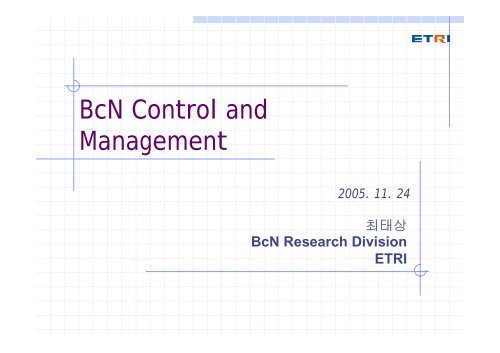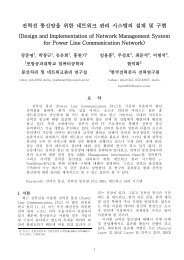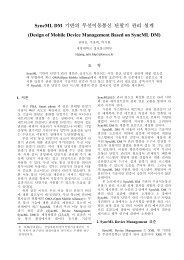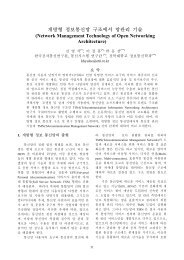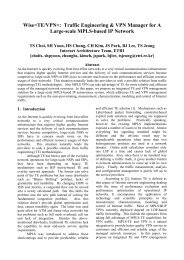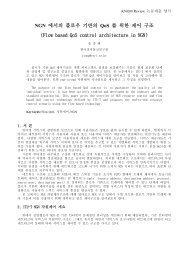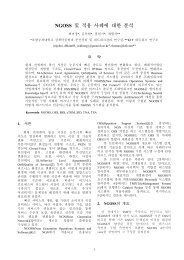BcN Control and Management - KNOM
BcN Control and Management - KNOM
BcN Control and Management - KNOM
You also want an ePaper? Increase the reach of your titles
YUMPU automatically turns print PDFs into web optimized ePapers that Google loves.
<strong>BcN</strong> <strong>Control</strong> <strong>and</strong><br />
<strong>Management</strong><br />
2005. 11. 24<br />
최태상<br />
<strong>BcN</strong> Research Division<br />
ETRI
Topics<br />
<strong>BcN</strong> Overview – Government View<br />
NGN – Other World’s <strong>BcN</strong><br />
Rationale for a New Network Architecture<br />
toward <strong>BcN</strong><br />
ETRI’s <strong>BcN</strong> Vision: A New Network<br />
Architecture<br />
NCP: <strong>Control</strong> <strong>and</strong> <strong>Management</strong> Platform for<br />
<strong>BcN</strong><br />
1
<strong>BcN</strong> Overview –<br />
Government View
Value Chain in IT Industry<br />
Value Chain & Role of Government•Private Sectors<br />
Introduction of<br />
New Services<br />
Construct<br />
New infrastructure<br />
Device/<br />
Components<br />
Contents & S/W<br />
(9 New Growth Engine )<br />
Industrialization<br />
License Approval<br />
Policy & Strategy<br />
Supporting St<strong>and</strong>ard<br />
Illegal Copy Prevention<br />
Overseas Expansion<br />
Service Method<br />
St<strong>and</strong>ardization<br />
Narrow path Tech.<br />
Test-bed<br />
Frequency Allocation<br />
Development of Tech.Basis<br />
Public Pilot Project<br />
Law & Regulation<br />
<strong>BcN</strong> Pilot Project<br />
competitive Market<br />
Initial Market<br />
Investment Fund<br />
Government<br />
Private Sectors<br />
Reinvestment<br />
Package S/W development<br />
Create Employment<br />
Production Basis<br />
Deploying Solution industry<br />
Expansion of a ripple effect<br />
R&D investment<br />
Competitive prime cost<br />
Applied S/W development<br />
Reinforcement of Export<br />
Service Ready<br />
Pilot Commercialization<br />
Expansion of Market Size<br />
Embedded S/W development<br />
Marketing<br />
3
IT839 Strategy<br />
Triggering positive feedback mechanism in the value chain<br />
8 New Services<br />
WiBro<br />
(2.3GHz Portable Internet)<br />
DMB<br />
Home Network<br />
Telematics<br />
RFID-based Service<br />
W-CDMA<br />
Terrestrial DTV<br />
IP Telephony (VolP(<br />
VolP)<br />
3 Infrastructures<br />
Broadb<strong>and</strong> Convergence<br />
Network (<strong>BcN</strong>(<br />
<strong>BcN</strong>)<br />
U-Sensor Network<br />
(USN)<br />
IPv6<br />
4<br />
9 Growth Engines<br />
NG Mobile Comm.<br />
Digital TV<br />
Home Network<br />
IT SoC<br />
NG PC<br />
Embedded SW<br />
Digital Contents<br />
& SW Solutions<br />
Telematics<br />
Intelligent Service Robot
But the traffic is still growing fast !<br />
eDonkey<br />
(P2P App.)<br />
Cyworld<br />
(Mini Homepage)<br />
Online<br />
Games<br />
5
Moment of Truth : stagnate or face the<br />
challenge<br />
Home<br />
Network<br />
IP<br />
HDTV<br />
Profit<br />
Premium<br />
Services<br />
VoIP<br />
Wibro<br />
Fixed price<br />
Best Effort<br />
Moment<br />
of Truth<br />
Marginal increase in the number of<br />
subscribers<br />
Current Biz Model,<br />
Sure way to die<br />
QoS Based IP Network<br />
New Biz Model,<br />
Dark <strong>and</strong> foggy way<br />
6
<strong>BcN</strong>: : the way to face challenge<br />
It is really a Moment of Truth,<br />
but the decision is very clear.<br />
Face the challenge,<br />
<strong>and</strong> <strong>BcN</strong> is the way to do it.<br />
7
Summary of <strong>BcN</strong> Deployment Strategies<br />
<strong>BcN</strong> Reference Model<br />
to provide guidelines to structures<br />
<strong>and</strong> inter-operability<br />
KT<br />
(Octave)<br />
Open API Platform<br />
to enable SMEs to develop<br />
applications easily<br />
<strong>BcN</strong> R&D Network<br />
Dacom<br />
(KGT)<br />
to provide Test-bed for <strong>BcN</strong><br />
applications <strong>and</strong> solutions<br />
<strong>BcN</strong><br />
Pilot<br />
Service<br />
<strong>BcN</strong> 시범사업<br />
SKT/Hanaro<br />
(UbiNet)<br />
QoS <strong>Management</strong><br />
System<br />
to insure QoS in <strong>BcN</strong> services<br />
with QoS index & monitoring<br />
8
<strong>BcN</strong> Pilot Service Project – 3 consortia<br />
KT<br />
Group<br />
SKT/Hanaro<br />
Group<br />
Dacom<br />
Group<br />
KT, KTF<br />
SKT, Hanaro<br />
Dacom, LGT, Powercom<br />
Samsung Elec., Corecess,<br />
Core Communications,<br />
Text<br />
Text<br />
Text<br />
iCrossTech,<br />
CNS, Wooksung, Herit, Uangel<br />
KBS, MBC, SBS, EBS<br />
Direct media, Singy,<br />
Carrot Korea, SON Korea<br />
KTI<br />
Samsung Elec., Herit, Xener,<br />
Telcoware, Mirinet, Wooksung,<br />
Text<br />
Text<br />
Text<br />
Samwoo, Uangel<br />
Hulim interactive, SK C&C,<br />
Secure soft, Entels, IDC Tech.<br />
SBS, SK communications, MBN,<br />
Skylife, Choongchung Broacasting<br />
Daehan cable, SK construction<br />
Wooksung, Acromate,<br />
Text<br />
Text<br />
Text<br />
LG CNS, CD Networks,<br />
Alticast, Uangel<br />
MBC, BSI, Dreamcity<br />
Daum Communications, Inotive<br />
KIST<br />
9
What is the Killer Application ?<br />
TPS = TV + Voice + Internet Access<br />
= Already existing markets<br />
Maybe, but no increase in the size of market<br />
Video Phone, Video Conferencing<br />
Perhaps, but requires long time to create substantial amount<br />
of new market<br />
e-Learning<br />
Most likely, especially in Korea<br />
10
What makes <strong>BcN</strong> based e-Learning e<br />
a killer<br />
application ?<br />
tens of billions $USD in private education : big potential market<br />
QoS <strong>Management</strong> : Ensuring high quality in streaming services<br />
Channel Selection point in <strong>BcN</strong> could be at Curbs, not at STBs<br />
Overcome the physical limitation of access lines<br />
Time shifting (Uni-casting based)<br />
Example<br />
Highly customized e-learning programs<br />
- High quality, HD<br />
- divided into 10 lecturers with different style<br />
- divided into 10 levels by difficulties<br />
- divided into 10 programs by progress<br />
- Time-Shifting any time, pause & repeat<br />
- Interactive pose questions <strong>and</strong><br />
answered in real time<br />
This is just one example.<br />
Many more to be developed<br />
during <strong>BcN</strong> pilot projects<br />
11
Vision & Goals of <strong>BcN</strong><br />
Vision<br />
To provide seamless, broadb<strong>and</strong>, integrated multimedia services<br />
anytime, anywhere by the year 2010<br />
To reach 20 million <strong>BcN</strong> subscribers by 2010 in Korea<br />
1,500,000<br />
4,500,000<br />
10,000,000<br />
Goals<br />
Wired (50~100M)<br />
2005<br />
<br />
2007<br />
<br />
2010<br />
500,000<br />
3,500,000<br />
10,000,000<br />
Wireless<br />
(50~100M at most)<br />
2005<br />
<br />
2007<br />
<br />
2010<br />
12
Conclusion<br />
<strong>BcN</strong> is not something to come in<br />
the future.<br />
It is a reality we are facing now<br />
in Korea.<br />
13
NGN – Other World’s <strong>BcN</strong>
ITU-T Key NGN QoS 표준 분야<br />
Performance objectives <strong>and</strong> classes: SG12, 16<br />
Application performance<br />
Network performance: Y.1540, Y.1541(IP)/Y.1561(MPLS)/I.356(ATM)<br />
Dynamic QoS controls: SG11, 13, FGNGN<br />
Signaling of performance requirements<br />
Dynamic activation of QoS controls<br />
Inter-provider QoS<br />
Interworking of QoS mechanisms<br />
Framework <strong>and</strong> guidelines<br />
Performance measurement <strong>and</strong> monitoring: SG4, 13, FGNGN<br />
M.2301, M.3341<br />
Performance assessment: SG12<br />
Other key SDOs involved in NGN QoS st<strong>and</strong>ardization include: 3GPP, 3<br />
GPP2, ATIS, IETF, ETSI TISPAN, MFA<br />
A major goal is to define a st<strong>and</strong>ard toolkit for providing session QoS<br />
end to end independent of access technology<br />
15
ITU-T NGN QoS 표준 현황<br />
FGNGN의 Framework & Architecture 관련 현재 진행 분야<br />
TR-FRA: 2005년 11월 완료목표(o)<br />
NGN Framework, 전체구조, 및주요기능명세표준<br />
FGNGN의 QoS 관련 현재 진행 중인 분야<br />
TR-RACF: 2005년 11월 완료목표(△)<br />
NGN 자원및수락제어표준<br />
TR-ngn.qos: 2005년 9월 완료목표(o)<br />
NGN 종단간 서비스 품질 개요 표준<br />
TR-ngn.NHNperf: 2005년 9월 완료목표(o)<br />
FR, ATM, IP 기술간 품질 등급 메핑 표준<br />
TR-PMM: 2005년 11월 완료목표(△)<br />
NGN 성능/품질 측정 표준<br />
TR-apo: 2005년 11월 완료목표(△)<br />
이종 사업자 종단간 성능 측정을 위한 알고리즘 표준<br />
TR-enet: 2005년 11월 완료목표(△)<br />
NGN 백본망의 이더넷 활용 표준<br />
TR-e2e-qos: 2005년 11월 완료목표(x)<br />
NGN 종단간 QoS 제어 및 관리 표준<br />
ITU-T SG13 관련 현재 진행 분야<br />
Y.ngn-account: 2006년 9월로 완료 목표 (△)<br />
NGN 과금 표준<br />
Y.17ethoam<br />
NGN 이더넷 OAM 표준<br />
(NOTE: 완성도: o - 높음, △ - 중간, x – 낮음)<br />
16
NGN Architecture Overview<br />
3 rd Party Application Providers<br />
ANI<br />
Service stratum<br />
Application Functions<br />
Services<br />
<strong>Management</strong> Functions<br />
End-User<br />
Functions<br />
Service User<br />
Profiles<br />
Transport User<br />
Profiles<br />
Network<br />
Attachment<br />
<strong>Control</strong> Functions<br />
Service <strong>Control</strong><br />
Functions<br />
Resource <strong>and</strong><br />
Admission<br />
<strong>Control</strong> Functions<br />
Transport <strong>Control</strong> Functions<br />
Media H<strong>and</strong>ling<br />
Functions<br />
<strong>Control</strong><br />
Other<br />
Networks<br />
UNI<br />
Access<br />
Access Transport<br />
Functions<br />
Functions<br />
Transport stratum<br />
Edge<br />
Functions<br />
Transport Functions<br />
Core Transport<br />
Functions<br />
Gateway<br />
Functions<br />
NNI<br />
<strong>Control</strong><br />
Media<br />
<strong>Management</strong><br />
17
NGN Generalized Functional<br />
Architecture<br />
<strong>Management</strong> functions<br />
UNI<br />
NACF<br />
T-18: T. User<br />
Profile FE<br />
T-16:<br />
T. Authentication<br />
&Authorization<br />
FE<br />
S-10: Subscription<br />
Locator FE<br />
A-2: Application Gateway FE<br />
S-8: Session <strong>Control</strong><br />
Proxy FE<br />
T-xx:<br />
T. Location<br />
mgt FE.<br />
T-17a:<br />
T. Network Access Configuration <strong>Control</strong><br />
FE<br />
S-2: S. User Profile FE<br />
S-7: Access GW<br />
<strong>Control</strong> FE<br />
RACF<br />
T-19: A-TRCF<br />
Multimedia<br />
Service FE<br />
A-1: Application Server FE<br />
(may include own Authentication, Authorization <strong>and</strong> Accounting)<br />
S-1: Session <strong>Control</strong> FE<br />
T-15: PD FE<br />
T-20: C-TRCF<br />
S-3: S. Authentication & Authorization FE<br />
S-11: Interrogating Session<br />
<strong>Control</strong> FE<br />
S-4: Media Resource<br />
<strong>Control</strong> FE<br />
T-7:<br />
Media<br />
Resource<br />
Processing<br />
FE<br />
S-6: Packet GW<br />
<strong>Control</strong> FE<br />
S-9: Breakout<br />
Gateway FE<br />
S-5: Media GW<br />
<strong>Control</strong> FE<br />
T-21: I-TRCF<br />
T-14:<br />
Signalling<br />
Gateway<br />
FE<br />
Application<br />
Service <strong>Control</strong><br />
NNI<br />
Other N<br />
other IP<br />
Netw<br />
(e.g. I<br />
Terminal<br />
Functions<br />
T-13: Access<br />
Relay FE<br />
T-10: Access<br />
Node FE<br />
T-4: Access<br />
Media<br />
Gateway<br />
FE<br />
T-a: MM-FE<br />
T-b: Multicast<br />
MBSFE<br />
T-8: MBS-FE<br />
T-8: Transport<br />
Resource &<br />
Enforcement<br />
FE<br />
T-12: Edge<br />
Node FE<br />
T-11: Access Packet Transport Functions<br />
T-9:<br />
Access<br />
Border<br />
Gateway<br />
FE<br />
T-8: Transport<br />
Resource &<br />
Enforcement<br />
FE<br />
T-8: MBS-FE<br />
T-b: Multicast<br />
MBSFE<br />
T-a: MM-FE<br />
T-1: Core Packet Transport Functions<br />
T-2:<br />
Packet<br />
Gateway<br />
FE<br />
T-5:<br />
Trunk<br />
Media<br />
Gateway<br />
FE<br />
Core Transport<br />
Inter<br />
PSTN/<br />
Scope of NGN<br />
18
RACF Functionality: TR.racf<br />
QoS control<br />
resource reservation<br />
admission control<br />
checking authorisation based on user profiles, SLAs, operator specific policy<br />
rules, <strong>and</strong> resource availability within access <strong>and</strong> core transport<br />
gate control<br />
NAPT <strong>and</strong>/or FW traversal control Functions over<br />
access <strong>and</strong> core transport networks<br />
19
RACF Position in NGN<br />
Service Stratum<br />
Service <strong>Control</strong> Functions<br />
Transport Stratum<br />
NAAF<br />
RACF<br />
Other NGNs<br />
CPE<br />
Transport Functions<br />
NAAF: Network Access Attachment Functions<br />
20
RACF Architecture<br />
AT&T<br />
KT<br />
FT<br />
NTT<br />
Cisco<br />
Lucent<br />
Huawei<br />
Nortel<br />
ZTE<br />
Service Stratum<br />
Transport Stratum<br />
Network Access<br />
Attachment Functions<br />
(Cf. FGNGN-OD-00165, May. ’05)<br />
Ub<br />
A-TRCF<br />
Service <strong>Control</strong> Functions<br />
Resource <strong>and</strong> Admission <strong>Control</strong> Functions<br />
Rq<br />
SCPF<br />
PDF<br />
Gq’<br />
Rq<br />
Rp<br />
SCF<br />
C-TRCF<br />
Work in progress<br />
Rq<br />
Gq’<br />
IBCF<br />
I-TRCF<br />
Iq<br />
X?<br />
Other NGNs<br />
Re<br />
Rc<br />
Re<br />
Go’<br />
Rc<br />
Go’<br />
Rc<br />
CPN<br />
Access Transport<br />
Core Transport<br />
R-BGF<br />
ANF<br />
ENF<br />
A-BGF<br />
I-BGF<br />
ANF - Access Node Function<br />
ENF - Edge Node Function<br />
A-BGF - Access Border Gateway Function<br />
I-BGF - Interconnection Border Gateway Function<br />
R-BGF - Residential Border Gateway Function<br />
IBCF - Interconnection Border <strong>Control</strong> Function<br />
PDF - Policy Decision Function<br />
SCF - Service <strong>Control</strong> Function<br />
SCPF - Service <strong>Control</strong> Proxy Function<br />
A-TRCF - Access Transport Resource <strong>Control</strong> Function<br />
C-TRCF - Core Transport Resource <strong>Control</strong> Function<br />
I-TRCF – Interconnection TRCF<br />
21
IP QoS Classes <strong>and</strong> Network<br />
Performance Objectives: Y.1541<br />
Terminal-to-Terminal QoS (Y.1541)<br />
Terminal<br />
Network QoS<br />
<strong>Control</strong><br />
Transport<br />
Network QoS<br />
<strong>Control</strong><br />
Transport<br />
Terminal<br />
Network QoS<br />
<strong>Control</strong><br />
Transport<br />
Network<br />
performanc<br />
e parameter<br />
QoS Class 0<br />
QoS Class 1<br />
QoS Class 2<br />
QoS Class 3<br />
QoS Class 4<br />
QoS Class 5<br />
(Unspecified<br />
)<br />
QoS Class 6<br />
QoS Class 7<br />
IPTD<br />
100 ms<br />
400 ms<br />
100 ms<br />
400 ms<br />
1 s<br />
U*<br />
100 ms<br />
400 ms<br />
IPDV<br />
50 ms<br />
50 ms<br />
U*<br />
U*<br />
U*<br />
U*<br />
U*<br />
U*<br />
IPLR<br />
1 × 10 –3<br />
1 × 10 –3<br />
1 × 10 –3<br />
1 × 10 –3<br />
1 × 10 –3<br />
U*<br />
1 × 10 –5<br />
1 × 10 –5<br />
IPER<br />
1 × 10 –4<br />
U*<br />
1 × 10 –6<br />
1 × 10 –6<br />
22<br />
Encompass key IP application<br />
categories<br />
Are relatable to practical IP<br />
network QoS mechanisms<br />
Can be achieved in realistic<br />
network implementations<br />
Are verifiable at network<br />
boundaries<br />
Are readily applicable to NGN<br />
Are being enhanced in ITU-T SG 12
Description of QoS, NP & QoE:<br />
TR.ngn.qos<br />
provide descriptions of NGN Quality of Service, Network Performance <strong>and</strong><br />
Quality of Experience;<br />
illustrate how the QoS, NP & QOE concepts are applied in NGN<br />
environment;<br />
describe performance aspects of the NGN including performance of service<br />
<strong>and</strong> transport stratum;<br />
provide a basis for common underst<strong>and</strong>ing of performance concepts useful<br />
to users <strong>and</strong> to the industries that compose the NGN (e.g., Fixed & mobile<br />
telecommunications, broadcasting, etc.).<br />
define the application QoS classes of the NGN<br />
Man-Machine<br />
Interface<br />
Network<br />
Interface<br />
Network<br />
Interface<br />
Man-Machine<br />
Interface<br />
User<br />
SP<br />
CPN<br />
AN<br />
CN<br />
AN<br />
CPN<br />
SP<br />
User<br />
QoE<br />
Network Performance for<br />
NGN<br />
Quality of Service for NGN<br />
23<br />
QoE
Mapping among IP, ATM <strong>and</strong> Frame<br />
Relay QoS classes: Y.ngn.NHNperf<br />
IP QoS Class<br />
0<br />
1<br />
2<br />
3<br />
4<br />
5<br />
6<br />
7<br />
ATM QoS Class<br />
4<br />
1<br />
1<br />
FR QoS Class<br />
0<br />
3<br />
2<br />
24
Performance Measurements <strong>and</strong><br />
<strong>Management</strong> for NGN: TR-pmm<br />
Unspecified options, parameters<br />
Concatenation of performance over<br />
multiple network segments<br />
Accuracy<br />
Data H<strong>and</strong>ling<br />
Define attributes to be measured<br />
Mean delay, delay variation,<br />
packet loss, unavailability<br />
Specify how attributes are measured<br />
Proposed default rollup period 1 hour<br />
Active probes tailored to service classes<br />
(telephony, multimedia streaming, low<br />
latency data)<br />
Default probe transmission period 1 sec.<br />
Clock synchronization to Cooridated<br />
Universal Time through GPS<br />
Algorithms for computing performance<br />
Specify the inter-PRS interface<br />
Performance<br />
Reporting<br />
System<br />
Service Provider A<br />
<strong>Control</strong>,<br />
Reports<br />
Summary reports,<br />
measurement requests<br />
Service Provider B<br />
<strong>Control</strong>,<br />
Reports<br />
Performance<br />
Reporting<br />
System<br />
Collection<br />
Platforms<br />
Config,<br />
Reports,<br />
Policing info<br />
Config,<br />
Reports,<br />
Policing info<br />
Collection<br />
Platforms<br />
Probes,<br />
Policing info<br />
Delay/Loss<br />
Probes<br />
Probes,<br />
Policing info<br />
Measurement<br />
Platforms<br />
PE/CEs<br />
PE/CEs<br />
25
NGN Accounting, Charging,<br />
& Billing: Y.ngn.account<br />
Work in progress since Dec. 2004<br />
Service <strong>and</strong> functional requirements<br />
Generic <strong>and</strong> functional architectures for accounting, charging,<br />
<strong>and</strong> billing<br />
Accounting <strong>and</strong> metering capabilities of various levels of<br />
information<br />
Duration only<br />
Volume only<br />
Flow-aware volume<br />
Contents level<br />
Service specific charging data info model vs service<br />
independent generic model<br />
Charging data info model for customer<br />
Charging data info model for inter-SP settlement<br />
Charging data export functional capabilities <strong>and</strong> protocol<br />
Inter-SP settlement functional capabilities <strong>and</strong> protocol<br />
Applicability scenarios of these capabilities<br />
<strong>Management</strong> <strong>and</strong> security of accounting, charging <strong>and</strong> billing<br />
elements<br />
26
Rationale for a New Network<br />
Architecture toward <strong>BcN</strong>
Problems in Current Networks<br />
No QoS Guarantee – Only CoS<br />
No Security Guarantee – MAC Spoofing, IP Spoofing<br />
No SLA Guarantee – No Performance Monitoring<br />
No IP Billing – No Real Packet Statistics<br />
Low Reliability – No UNI OAM, Protection/Restoration<br />
High Cost<br />
Subscriber<br />
Subscriber<br />
(IP-DSLAM)<br />
ONU<br />
GE-SW<br />
1 st Aggregation Switch<br />
(Dasan)<br />
OLT<br />
E/WDM-PON<br />
• Narrow B<strong>and</strong>width<br />
•High Cost<br />
LE T<strong>and</strong>em Toll<br />
2 nd Aggregation switch<br />
(Cisco 5~6000, Riverston)<br />
•No QoS<br />
• No Security<br />
• Low Reliability<br />
• High Cost : no metro network<br />
GES<br />
PSTN<br />
TGW<br />
CR<br />
Business<br />
Subscriber<br />
• Narrow B<strong>and</strong>width<br />
•High Cost<br />
Internet<br />
ER<br />
(Cisco 12000,7500 Family, Cosine, etc)<br />
28
Tech. Analysis (1) - QoS<br />
No Admission control<br />
No QoS Guaranteeing Traffic <strong>Control</strong><br />
CoS : Low Latency Queueing + Class-based WRR<br />
Only class based BW<br />
guarantee !<br />
2M<br />
5M<br />
1M<br />
2M<br />
5M<br />
1M<br />
2M<br />
5M<br />
1M<br />
Port Class 1<br />
Class 2<br />
Class n<br />
Class 1 : 22M<br />
Class 2 : 9M<br />
…<br />
Class n : 3M<br />
• No rate guarantee per flow<br />
• No delay guarantee per flow<br />
• No jitter guarantee per flow<br />
29
Tech. Analysis (2) – SLA, IP Billing<br />
Not Supported Real QoS Info<br />
No Performance monitoring<br />
No real-time TE<br />
<br />
Flow: Def’n is flexible, but<br />
generally any unique<br />
combination of 5 tuples:<br />
<br />
State: Managing <strong>and</strong><br />
maintaining the following<br />
information for each flow:<br />
Source Address<br />
Destination Address<br />
<br />
<br />
Switch Fabric Route<br />
Nexthop<br />
Forwarding Info<br />
Source Port<br />
<br />
Class<br />
Destination Port<br />
Protocol<br />
<br />
<br />
Rate<br />
Delay Variation<br />
QoS Info<br />
<br />
Byte Count<br />
<br />
Flow Duration<br />
Netflow<br />
Cisco CEF/Riverstone<br />
<br />
Packets Received/Dropped,<br />
Bytes Received/Dropped, etc.<br />
Statistics Info<br />
30<br />
Ref.) Caspian Networks
Tech. Analysis (3) - Reliability<br />
No UNI OAM<br />
No Secured Return Path for MPLS<br />
No Guarantee for Restoration time<br />
No Scalability for MPLS TE<br />
No scalability for CV<br />
MPLS Ping ?<br />
31
Tech. Analysis (4) - Security<br />
Only Protection for MAC Spoofing, IP snipping<br />
No Mechanism of Real-time Protection for Attack<br />
Black hole, Sink Hole<br />
No mechanism of Real-time detection<br />
Slow action using Routing protocol<br />
More complex of Routing protocol<br />
No QoS guarantee for Normal Traffic<br />
IBGP<br />
IBGP IBGP<br />
IBGP<br />
5 Distribute the routing<br />
info to the whole network (BGP)<br />
IBGP<br />
Triggered<br />
router<br />
IBGP<br />
1<br />
IBGP<br />
IBGP<br />
Attacking Traffic<br />
6 drop attacking traffic<br />
at network edge<br />
IBGP<br />
IBGP<br />
IBGP<br />
IBGP<br />
IBGP<br />
IBGP<br />
4 Configure routing<br />
info at the Triggered<br />
Router<br />
Black Hole Configuration (normally)<br />
32<br />
1<br />
2<br />
3<br />
4<br />
5<br />
6<br />
Normally configure Black Hole mode<br />
Detect attacking traffic<br />
Analyse IP Source / Destination address of<br />
attacking traffic<br />
Configure routing info at the Triggered Router<br />
Distribute the routing info to the whole<br />
network (BGP)<br />
Drop the attacking traffic at the network edge<br />
Operator<br />
2, 3<br />
Detect attacking traffic <strong>and</strong> analyse IP<br />
Source / Destination address<br />
of attacking traffic<br />
Net flow<br />
3 rd party Analyser Tool<br />
-TAPS<br />
- Arbor Networks, etc<br />
Ref.) 전자정부통신망 고도화 ISP
Tech. Analysis (5) - <strong>Control</strong>lability<br />
No Guarantee for Real-time controllability<br />
Slow Network Convergence<br />
Routing loop, black hole routes, suboptimal routes<br />
No flooding<br />
If larger than 5 sec,<br />
LSP retransmitted<br />
from neighbors<br />
Additional Delay<br />
for generation<br />
Delay for flooding<br />
Initial waiting time<br />
(5.5 sec)<br />
SPF computation<br />
time<br />
RIB/FIB updating<br />
time<br />
• Partial Route Calculation<br />
- Initial waiting time : 2 sec<br />
- Interval for PRC : 5 sec<br />
LSP generation & flooding<br />
- Transmission interval : 33 ms<br />
Min. interval of LSP<br />
(5 sec)<br />
Interval for consecutive SPF processing<br />
(10 sec) SPF Starts<br />
LSP receives<br />
from neighbors<br />
Ack (PSNP)<br />
RIB updates<br />
Completion of RIB/FIB updating<br />
Event occurs<br />
-Adjacency flap<br />
-Interface flap<br />
-Change in i/f metric<br />
-Change in inter-area routes<br />
-Change in redistributed (external) routes<br />
Time-gap !<br />
33
Tech. Analysis (5) - Instability<br />
Different Routing Table for each class -> No<br />
Scalability !<br />
Instability of routing architecture if the link cost<br />
depends on traffic<br />
E.g.) Delay, available b<strong>and</strong>width, packet loss<br />
Simple Cut-through
No New BM in IP Transport<br />
I.No QoS Guarantee :<br />
CoS based on Over-provisioning<br />
II. No Per-session IP Billing :<br />
Billing per class ONLY<br />
III. No QoS Guaranteed VPN Service :<br />
CoS based on Over-provisioning<br />
IV. Weekness for Network attacks :<br />
No QoS guarantee for normal Traffic<br />
• No QoS Routing<br />
• No Admission <strong>Control</strong><br />
• Slow Topology Re-configuration<br />
• Slow Traffic engineering<br />
• No Performance monitoring<br />
• No Per-session accounting<br />
• Sampled packet monitoring<br />
• No QoS Guarantee<br />
• No OAM<br />
• No per-flow Access control<br />
• No real-time detect mechanism<br />
35
ETRI’s <strong>BcN</strong> Vision: A New<br />
Network Architecture
Concept of New Architecture<br />
Paradigm Shift<br />
<strong>BcN</strong> = QoS-based Manageable NGN<br />
= Profitable Ng-IP Transport Network<br />
•No QoS<br />
•No OAM<br />
•No SLA<br />
• Low Reliability<br />
NCP<br />
• End-to-end QoS/SLA<br />
• High reliability<br />
• IP Billing<br />
IP<br />
Terminal<br />
IP<br />
Terminal<br />
IP<br />
Terminal<br />
Internet<br />
Lease Line, VLL<br />
L2/L3 VPN<br />
Multimedia, IP-TV<br />
Mobile Internet<br />
IP<br />
Terminal<br />
Traditional Uncontrollable-IP<br />
Transport Network<br />
<strong>BcN</strong><br />
Transport Network<br />
37
Concept of <strong>BcN</strong><br />
IP+MPLS<br />
<br />
-Distributed Topology discovery<br />
-IP Reachability <strong>Management</strong><br />
-Diffused Fault Recovery<br />
-Data Forwarding<br />
+ Diffserv Data Forwarding<br />
+ Flow control<br />
+ Statistics<br />
+ Policy-based TE<br />
+ Signaling<br />
+ OAM<br />
+ Resource discovery<br />
+ Mobility<br />
+ VPN <strong>Control</strong><br />
+ Security<br />
<br />
-Distributed Topology discovery<br />
-IP Reachability <strong>Management</strong><br />
-Data Forwarding<br />
-Diffused Fault Recovery<br />
More complex !<br />
(IP+MPLS)’<br />
=<strong>BcN</strong><br />
38<br />
•Topology <strong>Management</strong><br />
•Resource <strong>Management</strong><br />
•Policy <strong>Management</strong><br />
•SLA <strong>Management</strong><br />
•Network Security <strong>Management</strong><br />
•Global Mobility <strong>Management</strong><br />
Network<br />
<strong>Control</strong><br />
Platform<br />
<br />
-Inter-subnet IP Reachability<br />
-Localized Fault Recovery<br />
-Scalable end-to-end OAM<br />
-Flow-based QoS Forwarding<br />
-Flow-based Statistics<br />
Decoupling & Centralization
<strong>BcN</strong> <strong>Control</strong> Architecture<br />
Layered Open Architecture<br />
Service <strong>Management</strong> Plane<br />
Call/Session<br />
<strong>Control</strong> Plane<br />
NCP<br />
IP<br />
Terminal<br />
Internet<br />
Leased Line, VLL<br />
L2/L3 VPN<br />
Multimedia, IP-TV<br />
Mobile Internet<br />
IP<br />
Terminal<br />
Multi-service Managed IP Transport Network<br />
39
<strong>BcN</strong> Reference Model<br />
Need collaboration with ITU-T<br />
I/F-9<br />
I/F-1<br />
I/F-8<br />
Session<br />
Initiation<br />
System<br />
I/F-2<br />
SMS<br />
NCP<br />
I/F-7<br />
I/F-6<br />
I/F-5<br />
I/F-9<br />
To Peer Carrier<br />
To Peer Call Agent<br />
To Peer NCP or<br />
Upper level NCP<br />
I/F-3<br />
I/F-4<br />
CPE<br />
Edge<br />
(Service)<br />
Node<br />
Node<br />
Core<br />
Edge<br />
(Service)<br />
Node<br />
Other Access or<br />
Core Networks<br />
40
NCP: <strong>Control</strong> <strong>and</strong> <strong>Management</strong><br />
Platform for <strong>BcN</strong>
Basic Philosophy<br />
Introducing centralized control concept<br />
<br />
Hierarchical Structure for Scalabiliy <strong>and</strong> Availability<br />
I. Centralized Resource/Policy <strong>Management</strong><br />
- Managed QoS Routing<br />
- Admission/Access <strong>Control</strong><br />
- Policy-based Provisioning<br />
II.Integrated OAM<br />
- Fast Topology Re-configuration<br />
- Fast Fault Recovery<br />
- Scalable Real-time PM<br />
III.Real-time Monitoring<br />
- Real-time Traffic Engineering<br />
- Flow-based Network Emergency <strong>Control</strong><br />
IV.Per-session Accounting<br />
- Usage based IP Billing<br />
+ Flow-based TE<br />
• End-to-end QoS/SLA<br />
• QoS guaranteed VPN<br />
• Network reliability<br />
• Network Security<br />
• IP Billing<br />
V.Centralized Multicast <strong>Control</strong><br />
- Nation-wide IP multicasting<br />
Profitable NGN<br />
42
Policy-based QoS Routing<br />
QoS guaranteed Managed Routing<br />
Policy routing + policy-based VSP + real-time TE<br />
Based on<br />
Centralized resource management<br />
OAM-based fast topology re-configuration<br />
OAM-based fast fault recovery<br />
Real-time Path monitoring<br />
Policy-based<br />
Routing<br />
Policy-based<br />
Virtual Switched Path<br />
43
Admission & Authenticationbased<br />
Access <strong>Control</strong><br />
Admission <strong>Control</strong><br />
- both <strong>Control</strong> Plane <strong>and</strong> Data Plane<br />
Authentication-based Access <strong>Control</strong><br />
SSO System<br />
4.<br />
Session<br />
Initiation<br />
System<br />
5.<br />
13.<br />
Common<br />
Repository<br />
15.<br />
1. INVITE (w/ SDP)<br />
2. INVITE (w/ SDP)<br />
3. 183 Session Progress<br />
4. Decide Resource Spec.<br />
5. Resource Reservation Request<br />
6. Search Path & Decide Resource Availability<br />
7. Service Flow Information Delivery<br />
8. Resource Reservation Accept<br />
9. 183 Session Progress<br />
10.PRACK/ 200 OK (PRACK) /<br />
UPDATE / 200 OK (UPDATE)<br />
11. User Alerting<br />
12. 180 Ringing<br />
13. Resource Commit Request<br />
14. Update Resource Information<br />
15. Resource Commit Accept<br />
16. Call/Session Accept<br />
17. Talking<br />
6.<br />
8.<br />
14.<br />
NCP<br />
3.<br />
2.<br />
7.<br />
Service flow Info.<br />
16.<br />
10.<br />
12.<br />
1.<br />
9.<br />
Core<br />
SE<br />
17. Talking<br />
SE<br />
Core<br />
MPLS Path<br />
Core<br />
Core<br />
SE<br />
11. Alerting<br />
44
Flow-based Traffic <strong>Control</strong><br />
QoS based only on class<br />
2M<br />
5M<br />
1M<br />
2M<br />
5M<br />
1M<br />
2M<br />
5M<br />
1M<br />
Port Class 1<br />
Class 2<br />
Class n<br />
Only class based QoS !<br />
Class 1 : 22M<br />
Class 2 : 9M<br />
…<br />
Class n : 3M<br />
• No rate guarantee per flow<br />
• No delay guarantee per flow<br />
• No jitter guarantee per flow<br />
Class <strong>and</strong> flow based QoS !<br />
QoS based on flow <strong>and</strong> class<br />
2M<br />
5M<br />
1M<br />
2M<br />
5M<br />
1M<br />
2M<br />
5M<br />
1M<br />
Port Class 1<br />
Class 2<br />
Class n<br />
Flow 1 :<br />
1M<br />
Flow 2 :<br />
2M<br />
…<br />
Flow n :<br />
5M<br />
Class 1 :<br />
22M<br />
Class 2 :<br />
9M<br />
…<br />
Class n :<br />
3M<br />
• Guaranteed rate per flow<br />
• Guaranteed delay per flow<br />
• Guaranteed jitter per flow<br />
WRR : Weighte Round Robin<br />
WFQ : Weighted Fair Queueing<br />
45
OAM-based MPLS : SMPLS<br />
IP/MPLS vs. SMPLS<br />
TD/RD<br />
QoS/SLA<br />
CV<br />
Return path for<br />
OAM<br />
Path<br />
Protectio<br />
ntime<br />
LSP<br />
fail<br />
Link<br />
fail<br />
IP/MPLS<br />
Distributed<br />
CoS<br />
RSVP Refresh<br />
IP Packet<br />
3 x refresh + restoration<br />
FRR (No return Path)<br />
SMPLS<br />
Centralized<br />
Guaranteed QoS<br />
(w/ Statistical<br />
multiplexing)<br />
OAM packet<br />
Pre-determined return path<br />
3 x ( 20 ms ~ 1 sec) +<br />
restoration<br />
OAM-based FRR<br />
46
QoS Monitoring<br />
SLA based QoS Guaranteed Service<br />
St<strong>and</strong>ard Time<br />
[Statistics for SLA]<br />
NTP<br />
• Statistics<br />
• Trap (MPLS, VLAN Fault)<br />
Identifie<br />
r<br />
Availabil<br />
ity<br />
B<strong>and</strong>wid<br />
th<br />
Performan<br />
ce<br />
Dela<br />
y<br />
Jitter<br />
Loss<br />
Rate<br />
Connection ID : 5<br />
OAM<br />
Transport Network<br />
OAM<br />
OAM Frame<br />
Insertion<br />
MPLS OAM <strong>and</strong> Statistics per LSP<br />
OAM Frame<br />
Processing<br />
VLAN OAM <strong>and</strong> Statistics per VLAN (Delay, Jitter, Time to Fault <strong>and</strong> Recovery)<br />
Per-Connection Performance Measurements<br />
47
Real-time TE & Flow-based Network<br />
Security<br />
Real-time per-flow monitoring<br />
High Performance<br />
Embedded Flow Monitor<br />
Real-time Path<br />
monitoring<br />
Per-flow<br />
Traffic Statistics<br />
Netflow/Cflow-based analysis<br />
• Real-time Traffic Engineering<br />
• Real-time Emergency Detect & <strong>Control</strong><br />
(Rate control based Network Security)<br />
• Long-term Traffic Engineering<br />
• IP Billing<br />
48
Flow-based TE<br />
(Policy-based Provisioning)<br />
Flow-based QoS Guarantee<br />
Per-flow admission control<br />
Real-time TE<br />
Policy<br />
<strong>Management</strong><br />
SLA<br />
<strong>Management</strong><br />
SLS<br />
Analysis<br />
Call<br />
Statistics<br />
Policy<br />
Activator<br />
VSP<br />
Planner<br />
Network<br />
Monitoring<br />
Flow-based<br />
PHB<br />
Node<br />
monitoring<br />
Policy-based<br />
Flow-to-VSP Mapping<br />
Path<br />
monitoring<br />
Policy-based<br />
Flow-to-VSP Mapping<br />
Node<br />
monitoring<br />
Flow-based<br />
PHB<br />
Flow-based<br />
Traffic <strong>Control</strong><br />
Real-time Traffic Engineering<br />
Over<br />
Virtual Switched Path Network<br />
OAM per VSP(LSP)<br />
PM per Sampled flow per class<br />
Flow-based<br />
Traffic <strong>Control</strong><br />
49
NCP’s Functional Framework<br />
I/F-9<br />
I/F-8<br />
BSS/<br />
NSS<br />
I/F-9<br />
To Peer Carrier<br />
Service<br />
Stratum<br />
I/F-2<br />
Call Agent/<br />
SIP Proxy<br />
I/F-7<br />
I/F-6<br />
To Peer Call Agent<br />
Transport<br />
Stratum<br />
NCP<br />
Call<br />
Admission<br />
Path<br />
Activation<br />
Multicast<br />
Manager<br />
Path<br />
Computation<br />
Policy<br />
Activator<br />
HLR<br />
Dynamic<br />
Capacity<br />
Planner<br />
Monitoring<br />
& TE<br />
DNS<br />
Resource/<br />
Topology<br />
Discovery<br />
SLS<br />
Analyzer<br />
Global<br />
Emergency<br />
Manager<br />
Route<br />
Reflector<br />
I/F-5<br />
To Peer NCP or<br />
Upper level<br />
NCP<br />
I/F-1<br />
I/F-3<br />
I/F-4<br />
CPE<br />
Edge<br />
(Service)<br />
Node<br />
Core<br />
Node<br />
Edge<br />
(Service)<br />
Node<br />
Other Access or<br />
Core Networks<br />
50
Profitability of <strong>BcN</strong> <strong>and</strong> NCP<br />
Managed QoS Routing<br />
OAM-based Fast Topology Re-configuration<br />
Managed VPN Provisioning<br />
Admission <strong>Control</strong><br />
Real-time Performance Reporting<br />
Real-time Traffic Engineering<br />
Flow-based Network Emergency <strong>Control</strong><br />
Per-session Accounting<br />
Real Profitable<br />
Ng-IP Network<br />
Service Manager<br />
(Integrated Portal)<br />
B-NCP<br />
M-NCP<br />
M-NCP<br />
AGW<br />
B-ESN<br />
B-ESN<br />
AGW<br />
Aggregation<br />
Switch<br />
AGW<br />
Metro Core Metro Core Backbone<br />
Edge<br />
TGW<br />
Backbone<br />
Edge<br />
Metro Core<br />
TGW<br />
Metro Core<br />
Aggregation<br />
Switch<br />
AGW<br />
IPv4/6 IPv4 packet IPv4 VSP<br />
51
Thank you !<br />
choits@etri.re.kr


